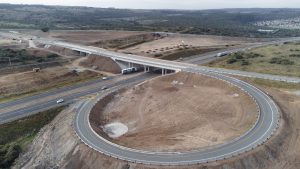MEDIA RELEASE
SANRAL OPENS N2 BELSTONE INTERCHANGE TO TRAFFIC
Caption: Construction of the Belstone Interchange along the N2 near Bhisho has been completed
Gqeberha, 24 July 2024 – The South African National Roads Agency SOC Limited (SANRAL) has announced the opening of the N2 Belstone Interchange and route MR0688 linking Bhisho to Zwelitsha to traffic today.
This follows a 33-month construction period, which commenced in September 2021. Valued at R438 million, the project was critical to address the high accident rate at the old Breidbach intersection and the traffic congestion at the intersection of the MR0690 and MR0688. Safety and flow of traffic were thus central in its design and construction.
“The upgrades to this section of the N2 will result in improved management of traffic flow from Bhisho, Breidbach, Zwelitsha and East London, and improved safety for pedestrians and other non-motorised road users. The one loop and off-ramp will present safer access to the N2 and improve safety for both motorists and
pedestrians,” said Mbulelo Peterson, SANRAL’s Regional Manager for its Southern Region.
The upgrades included construction of new interchanges at the Belstone and the Breidbach intersections, construction of a link road from Breidbach towards Sweetwaters outside Zwelitsha, free-flowing interchange at Belstone Bridge, dualling of the MR0688 road Bhisho and reinforcement of the concrete structures with the necessary road works.
“The benefit to the community goes beyond the new and safer road infrastructure. Through this project, SANRAL was able to create job opportunities for 376 general workers from the local community, with about R106 million spent on wages of targeted labour.”
“Over R194 million was spent on 100 targeted enterprises (SMMEs) who were subcontracted on the project. Furthermore, SANRAL invested over R4.6 million towards formal training of 614 locals by accredited training service providers to contribute to the skills development and capacitation of targeted enterprises. This was done to ensure that they can be self-sufficient beyond the SANRAL project,” said Peterson.
//Ends



